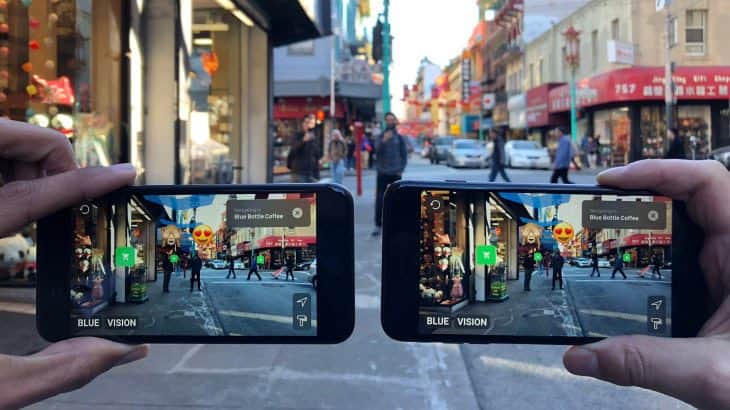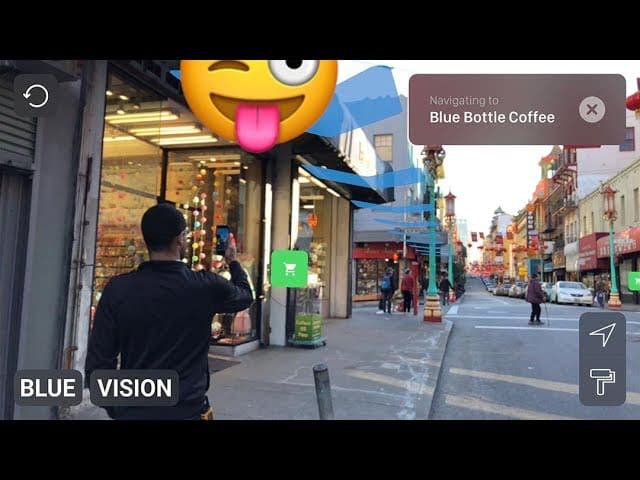[Update: In October 2018, Blue Vision Labs was acquired by Lyft to support its self-driving car project].
If VR has its challenges as a social platform, the idea of collaborative Augmented Reality seems even more elusive. Both Apple’s ARKit and Google’s ARCore have been firmly rooted in the single user category. But a London start-up, Blue Vision Labs, has just emerged from stealth mode with Series A funding of $14.5 Million from GV (formerly Google Ventures).
Founded two years ago by five friends with gaming, software, robotics, and driverless car backgrounds, Blue Vision says it is creating
The world’s first augmented reality cloud platform for building city-scale, shared and persistent experiences.

This is multiuser Augmented Reality with persistent digital objects that opens up incredible possibilities for learning, gaming, and retail in a social space.
You can check out their vision of collaborative augmented reality in the short video below (cut the volume if the off-Indie soundtrack gets to you):
Collaborative Augmented Reality Experiences
In TechCrunch, Ingrid Lunden says that,
Peter Ondruska, the startup’s co-founder and CEO, tells me that Blue Vision’s tech can pinpoint people and other moving objects in a space to within centimeters of their actual location — far more accurate than typical GPS — meaning that it could give better results in apps that require two parties to find each other, such as in a ride-hailing app. (Hands up if you and your Uber driver have ever lost each other before you’ve even stepped foot in the vehicle.)
Thankfully, Blue Vision’s practical sensibility spills over to the hardware side. Some of us may get our hands on Magic Leap’s newly released device, but the cost will keep it out of the mass market for the next few years. Blue Vision will work with the tech you already have – your Smartphone – cutting the barrier to entry. Of course, AR Glasses would be better, but that’s a year or two down the road.
Peter Ondruska, Co-founder and CEO of Blue Vision Labs shares how they will revolutionize the way we use AR in Medium,
Augmented reality has now reached hundreds of millions of people, but its potential is still very limited. For example, in a state-of-the-art AR game, you can place a digital object into your surroundings, but your friend would not be able to see it through their own device at the same place. This is because the component that connects everything together is missing.
We solved this by developing AR Cloud computer vision technology. The key part of our technology is a high-accuracy AR map of entire cities, which is stored in the cloud and perpetually updated. It houses AR content and also allows users’ phones to determine their positions with centimeter precision based only on the visual information from the camera. It allows us to turn entire cities into digital canvases upon which immersive digital experiences can be built.
If you’re an AR developer, you may be able to get early access to the SDK. Highly detailed maps have already been built for New York, London, and San Francisco so in effect you’re leveraging an already built platform. With the heavy lifting done on the backend, developers could push this forward quickly.
Peter Ondruska’s last line resonates deeply with us – the city becomes multiple digital canvases for immersive experiences. If you thought Pokemon Go or Snapchat had an impact, just wait. This is the real beginning of our immersive AR future.
Collaborative Augmented Reality could be a game-changer, transforming our experience of urban space and our social interactions. As Blue Vision says,
This is augmented reality as it should be.

Emory Craig is a writer, speaker, and consultant specializing in virtual reality (VR) and generative AI. With a rich background in art, new media, and higher education, he is a sought-after speaker at international conferences. Emory shares unique insights on innovation and collaborates with universities, nonprofits, businesses, and international organizations to develop transformative initiatives in XR, GenAI, and digital ethics. Passionate about harnessing the potential of cutting-edge technologies, he explores the ethical ramifications of blending the real with the virtual, sparking meaningful conversations about the future of human experience in an increasingly interconnected world.

